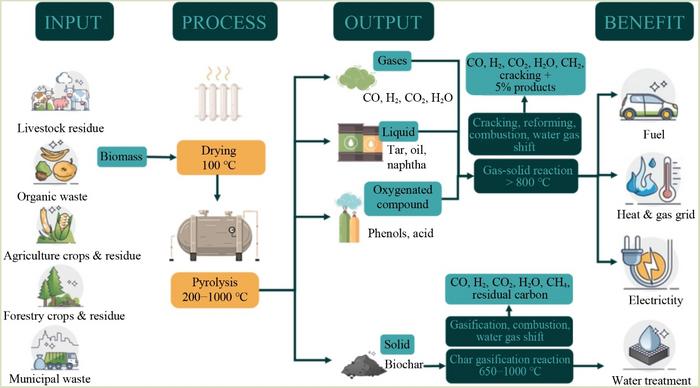
As the global population surges and urban centers continue their relentless expansion, humanity faces escalating environmental challenges that demand urgent and innovative solutions. Among these pressing concerns are the effective management of wastewater laden with emerging contaminants, the degradation of agricultural soils, and the intensification of climate change impacts. Conventional wastewater treatment facilities, while historically effective for traditional pollutants, often falter when confronted with complex contaminants such as heavy metals and pharmaceutical residues. Similarly, common agricultural and industrial practices exacerbate soil depletion, amplify water pollution, and contribute significantly to greenhouse gas emissions. These intertwined socio-environmental issues necessitate the development of sustainable technological innovations capable of simultaneously enhancing agricultural productivity, mitigating pollution, sequestering carbon, and valorizing waste materials.
Within this critical landscape, recent advancements spotlight the burgeoning potential of biochar-based nanocomposites (BNCs), an ingenious fusion of nanotechnology and biomass pyrolysis. In a groundbreaking study published in Frontiers of Agricultural Science and Engineering, researchers Gasim Hayder of the University of Nizwa and Dr. Rosli Muhammad Naim of the National Energy University of Malaysia propose these nanocomposites as a multifaceted solution to the dual challenges of wastewater treatment and renewable energy production. By repurposing agricultural and livestock waste, BNCs promise to transform environmental liabilities into valuable assets, establishing a new frontier in sustainable resource management.
The synthesis of BNCs begins with the pyrolysis of diverse waste biomass sources, including rice husks, straw, and livestock manure, conducted between temperatures of 350 to 800 degrees Celsius under oxygen-limited conditions. This thermal decomposition generates biochar, a carbon-rich solid byproduct endowed with a highly porous structure and functional groups such as surface hydroxyls and carboxyls. Through subsequent impregnation with metal salts or exposure to plasma treatments, biochar is modified with nanoscale materials to produce nanocomposites endowed with superior physicochemical properties. This meticulous engineering of BNCs not only enhances adsorption capacities but also imparts catalytic functionalities critical for addressing complex mixtures of pollutants present in wastewater.
Empirical investigations into the wastewater remediation capabilities of BNCs have yielded promising results. The presence of hydroxyl and carboxyl groups on the biochar surface facilitates selective adsorption of heavy metals, with lead and cadmium removal efficiency reaching staggering levels of 98.6% and 99.2% respectively. The nanocomposites’ intricate nano-porous architecture enables the capture of harmful synthetic dyes and antibiotic residues through strong π–π interactions, effectively mitigating organic pollution. Furthermore, when modified with photocatalytic titanium dioxide (TiO₂), BNCs exhibit pronounced degradation abilities towards pharmaceutical contaminants under ultraviolet light irradiation, heralding a new era of photocatalytic wastewater treatment technologies.
Beyond purification, BNCs offer exceptional promise as renewable energy vectors. Pyrolysis byproducts such as syngas can be harnessed directly for electricity generation or serve as precursors in biofuel synthesis pathways. The biochar itself, boasting a calorific value ranging from 25 to 30 megajoules per kilogram, represents a dense energy reservoir for thermal applications. Moreover, the intrinsic electrical conductivity and high surface area of BNCs position them as ideal candidates for advanced energy storage systems including supercapacitor electrodes and components within microbial fuel cells. Such multifunctionality enables the coupling of wastewater treatment processes with simultaneous power generation, exemplifying integrated environmental engineering solutions.
From an economic perspective, BNCs present a highly competitive alternative to conventional materials. Priced at approximately $150 per ton, their production costs equate to merely 15% to 30% of those associated with commercial activated carbon, a widely used adsorbent in wastewater treatment. The adoption of waste biomass as feedstock not only leverages inexpensive raw materials but also contributes significantly to carbon capture efforts. Each ton of biomass converted into biochar results in the sequestration of approximately 0.8 tons of carbon dioxide, underscoring the dual environmental benefit of pollution control and greenhouse gas mitigation.
Durability and reusability remain pivotal attributes in evaluating adsorbent materials, and BNCs demonstrate notable performance in this regard. Even after five to eight cycles of adsorption-desorption, they retain about 80% of their initial adsorption capacity, ensuring prolonged effectiveness and reduced operational costs. This resilience, coupled with their multifunctional capabilities, positions BNCs to contribute directly to multiple United Nations Sustainable Development Goals, including SDG 6 focusing on clean water and sanitation, SDG 7 promoting affordable and clean energy, and SDG 13 aimed at climate action.
Technological advancements in material synthesis, surface functionalization, and process optimization continue to enhance BNCs’ performance and scalability. Concurrently, policy frameworks encouraging sustainable industry practices and circular economy models provide an enabling environment for rapid uptake. Experts foresee that within the next five years, BNCs will gain mainstream traction in both wastewater treatment and renewable energy sectors, catalyzing a paradigm shift towards environmentally responsible and resource-efficient management systems.
The integration of nanotechnology with biomass conversion not only amplifies the functionalities of biochar but also demonstrates a creative approach to transforming environmental crises into valuable opportunities. By innovatively addressing the intertwined problems of pollution and energy scarcity, BNCs epitomize the convergence of science, sustainability, and socioeconomic feasibility. As the global community races toward sustainable development, adopting such multifaceted materials promises to pave the way for resilient and adaptive environmental technologies.
In conclusion, biochar-based nanocomposites represent a sophisticated technological breakthrough poised to redefine sustainable wastewater treatment and renewable energy generation. Their proficiency in adsorbing diverse contaminants, catalyzing pollutant degradation, enabling energy storage, and sequestering carbon positions them uniquely at the confluence of environmental remediation and clean energy solutions. As research progresses and industrial scaling improves, BNCs may well emerge as indispensable tools in the global endeavor to safeguard ecosystems while fulfilling humanity’s growing resource needs.
Subject of Research: Not applicable
Article Title: Biochar-based nanocomposites from waste biomass: a sustainable approach for wastewater treatment and renewable bioenergy
News Publication Date: 14-Jan-2025
Web References: http://dx.doi.org/10.15302/J-FASE-2024592
Image Credits: Gasim HAYDER, Rosli Muhammad NAIM
Keywords: Agriculture
Tags: agricultural waste repurposingbiochar-based nanocompositesclimate change mitigation technologiesdual-purpose environmental technologiesemerging contaminants managementgreenhouse gas emissions reductionnanotechnology in agriculturepollution reduction strategiesrenewable energy productionsoil health improvementsustainable environmental solutionswastewater treatment innovations





